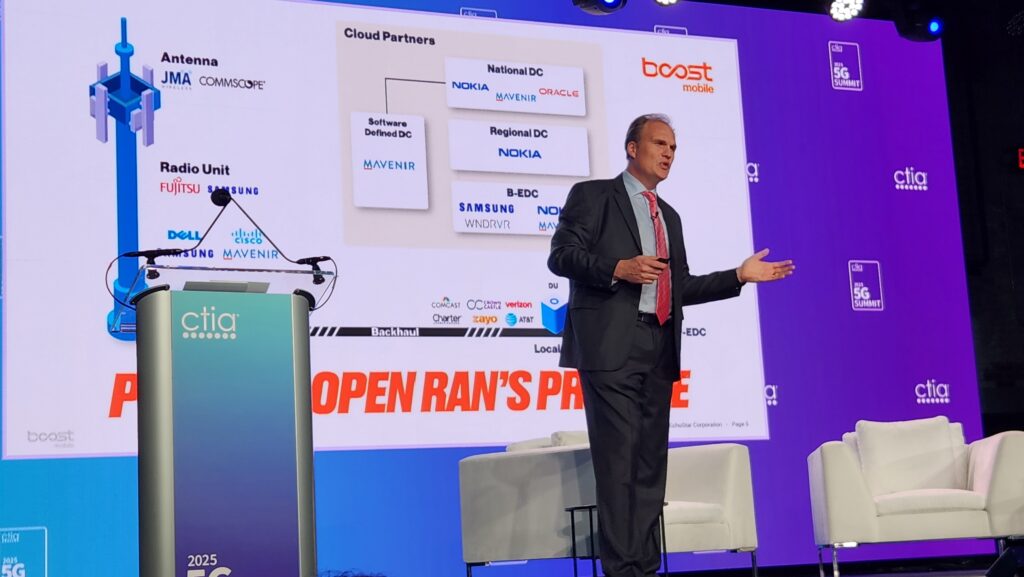Reconciliation invoice textual content takes the decrease 3 GHz, 6 GHz out of competition for public sale. The place does this go away CBRS?
New mark-up language dropped final night time for the federal funds invoice, and it features a reauthorization of federal spectrum public sale authority via 2034 and a requirement to establish 600 megahertz of spectrum that may be auctioned for unique, licensed use—however it takes the decrease 3 GHz and the 6 GHz unlicensed bands out of competition for public sale.
The Home Power and Commerce Finances Reconciliation textual content might be thought of this week. The proposed textual content requires the Federal Communications Fee and NTIA to establish 600 megahertz of spectrum to be recognized for reallocation “on an unique, licensed foundation” for cellular and/or fastened broadband companies inside two years, and for the FCC to public sale a minimum of 200 megahertz inside three years. It doesn’t specify which bands, however consists of the caveat that public sale proceeds should cowl 110% of federal relocation or sharing prices.
The textual content additionally proposes that FCC public sale authority be prolonged till 2034.
As Congress works to get President Trump’s “large, lovely invoice” via, it’s looking for to make funds numbers work partly by bringing in extra income via lining up spectrum auctions. This requires a reauthorization of the Federal Communications Fee’s statutory authority to public sale airwaves (which lapsed in early 2023) in addition to elevating the query of precisely which spectrum ought to be auctioned.
CTIA’s new President and CEO Ajit Pai wrote in a current Wall Road Journal op-ed that the wi-fi business wants a minimum of 600 megahertz of spectrum to problem China’s wi-fi expertise management—precisely the quantity which Congress needs to public sale—and that auctioning a lot spectrum may elevate as much as $200 billion.
However which spectrum can be auctioned? One of many long-standing sticking factors in Congressional reauthorization of the FCC’s public sale authority has been an absence of settlement on a spectrum pipeline. The spectrum surroundings is more and more constrained and aggressive: Cellular community operators need to help each cellular and bandwidth-hungry Mounted Wi-fi Entry companies. Area makes use of of spectrum have gotten extra demanding as properly. With the federal authorities and significantly, the Division of Protection, holding nearly the entire candidate bands for reallocation, what are the prices and the dangers to nationwide safety, and the way ought to industrial calls for be balanced?
The Biden administration had sought examine of practically 2,800 megahertz of spectrum, with an emphasis on spectrum sharing because the default strategy. The following bands teed up in that Nationwide Spectrum Technique have been 37 GHz, the decrease 3 GHz band from 3.1-3.45 GHz and spectrum within the higher midband at 7-8 GHz. These research have been supposed to incorporate determining whether or not airborne radars and different federal techniques within the decrease 3 GHz band might be repacked, compressed or relocated to permit industrial use of the band.
In current weeks, the Home and Senate Armed Providers Committees have been briefed on potential spectrum bands that the DoD sees because the most definitely bands for shifting its current techniques, or conversion to industrial wi-fi use. Based on two sources accustomed to the content material of the DoD spectrum briefings, a few of the bands supplied up as prospects weren’t truly federal bands or bands through which DoD operates; nor was there a dedication from the company to help reallocation of particular bands; and DoD didn’t handle points associated to industrial incumbents.
“It’s one factor for DoD to say they may relocate their techniques. It’s one other factor for them to say they may,” mentioned a kind of sources.
Maybe essentially the most controversial a part of that proposal was, in line with printed reviews, the doable vacating of 100 megahertz of the CBRS band in order that it might be re-auctioned for high-powered, unique use.
Whereas cellular community operators together with AT&T and T-Cellular US have been pushing for years for the FCC to permit higher-power operations within the CBRS band, to enhance propagation and cut back the variety of websites need to be deployed for a CBRS protection layer, the proposal to truly transfer Precedence Entry License (PAL) holders and Normal Approved Entry (GAA) customers out of the band is a a lot newer twist.
That proposal intently resembled an concept that has been round since late 2024, when AT&T EVP of Federal Regulatory Relations Rhonda Johnson floated a “new imaginative and prescient” for the three GHz band: Transfer CBRS customers to the decrease part of the three GHz band, at 3.1-3.3 GHz, and public sale the CBRS spectrum at 3.55-3.7 GHz for licensed, full-power use that may additionally create contiguous operations for full-powered 5G from 3.4 GHz to the higher restrict of the auctioned C-Band spectrum.
AT&T mentioned in an announcement supplied to RCR Wi-fi Information final week: “We proceed to help the concept a rethinking of the three GHz band may help unlock extra mid-band spectrum to help 5G. This consists of relocating CBRS to the decrease 3 GHz vary, increasing the quantity of spectrum allotted to it, after which opening 3.55-3.7 GHz to public sale for licensed, full-power use – all of which might assist to understand the utmost potential of spectrum throughout the three GHz band.”
CBRS proponents reacted swiftly to the information that Congress would possibly truly approve a plan that may relocate industrial CBRS customers, with protests that such a transfer would destroy greater than the numerous, home growth within the CBRS band—one through which the U.S. has established personal wi-fi community management and through which round 450,000 CBRS units are energetic, in line with GSA figures—in addition to seemingly kick off years of litigation if present license holders have been abruptly kicked out of the band. If a CBRS relocation have been undertaken, it wouldn’t be decisive or quick, mentioned one of many sources accustomed to the continuing spectrum discussions on the Hill. “That is the place the Congressional course of ignores inconvenient realities,” the supply added.
Dr. Robert Spalding, Brig Gen, USAF (Ret), is CEO of SEMPRE, which offers safe, hardened CBRS and Open RAN personal networks for industrial and protection use instances together with catastrophe restoration and detecting and elimonating drone threats. “One of many nice issues about CBRS is, we will go wherever and set actually quick. Our techniques are designed to be deployed by anybody—you don’t have to know something about mobile or cloud, you simply plug it in, flip it up and function it,” he mentioned.
Spalding mentioned that CBRS and O-RAN are the 2 pillars of supporting new entrants within the U.S. telecom market, and a novel technological benefit for a rustic which not has a significant, home-grown infrastructure supplier. “I imagine that digital sovereignty is necessary. Knowledge safety is necessary,” he mentioned. “I believe not having a telecom [infrastructure] business, from a nationwide safety perspective, places America in danger.”
And, if small companies which have been constructed across the availability of a developed CBRS infrastructure, chipset, module and gadget ecosystem have been requested to maneuver out of the band and begin over, Spalding mentioned, “I don’t assume any of those firms survive. In order that’s the horrible factor, and the large factor.”

“CBRS has made america the worldwide chief in each dynamic spectrum administration and personal mobile networks, completely aligned with the Trump Administration’s directives to guard American innovation and to advertise these American-led applied sciences overseas. And personal networks are only one instance of the vary of CBRS use instances, with others together with cellular community capability augmentation, different cellular companies, fastened wi-fi entry, and subsequent gen in-building impartial host options,” mentioned Dave Wright, coverage director for Spectrum for the Future, in an announcement to RCR Wi-fi Information.
He added: “CBRS’ immense worth to American business, companies, and residents is obvious, and we hope to see our policymakers give it the consideration it deserves.”
The Home committee mark-up textual content might assuage a few of the issues of CBRS advocates, because it seems to take essentially the most direct path for migration off the desk by carving 3.1-3.45 GHz out of competition as a candidate for public sale. If they can’t migrate to the decrease 3 GHz band, it might be that CBRS customers aren’t requested emigrate in any respect—though that is still to be seen.
The invoice additionally exempts 5.925-7.125 GHz from public sale, which was allotted to unlicensed use—primarily Wi-Fi—below former FCC Chair Jessica Rosenworcel, regardless of pushback from the MNO group on the latter as properly.
That doesn’t imply there aren’t any seemingly adjustments forward for CBRS—and so they may very properly enhance the utility of the band, in line with Iyad Tarazi, CEO of Federated Wi-fi, which helps CBRS deployments. Adjustments to CBRS operations have already elevated the utility of the band, Tarazi mentioned. “We nonetheless can do extra. I believe that may be nice. That’s the place I see this dialogue going,” he mentioned.
The FCC has had a proposed rulemaking within the works for awhile that reexamines CBRS operations, Tarazi famous. Enabling a number of choices for increased energy ranges is perhaps a possible middle-ground. Current customers might be grandfathered in, with their low-power operations protected, however the working guidelines of PALs may modified to permit higher-power operations as properly. Federated, he added, has modeled right down to the family stage that quite a lot of adjustments to CBRS operations may safely be carried out with out interfering with current customers or commercial-to-commercial sharing—which he mentioned is a extra regularly raised subject within the band than problems with sharing with the precise DoD incumbents. Higher understanding of the techniques, extra superior knowledge capabilities and help from firms like NVIDIA can sharpen and refine CBRS sharing in a method that enhance the utility of the band.

Ultimately week’s CTIA 5G Summit, in the meantime, EchoStar CTO Eben Albertyn used a part of his time on-stage to name for a refreshing of the CBRS band to incorporate high-power operations, calling it a “win-win-win scenario.” CBRS, he mentioned is “a band that has proven us how we will have a number of folks utilizing the identical band, and innovate in the identical band. However the truth that it’s low-power signifies that its advantages haven’t been seen.” The “win-win-win”, as he laid it out, was that no public sale must be held to alter working energy ranges; it will higher make the most of the band; and current customers wouldn’t be impacted, in line with evaluation that EchoStar has accomplished.
“If we give it excessive energy, we are going to considerably enhance the utilization of over 100 megahertz of essentially the most worthwhile spectrum that we now have within the U.S., and we will achieve this in a short time,” Albertyn mentioned, including: “There are zero downsides to doing this.”